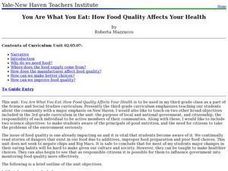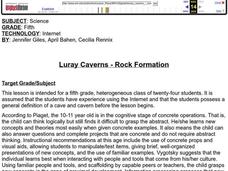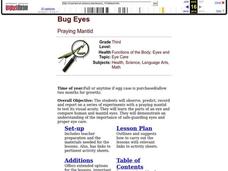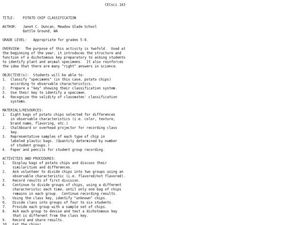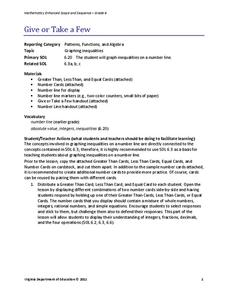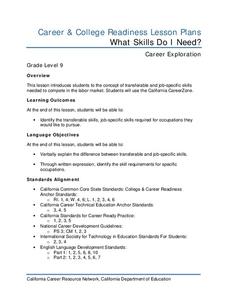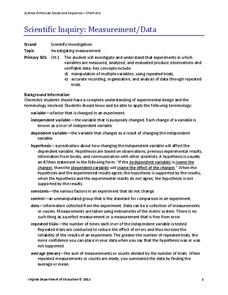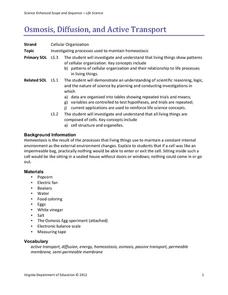Curated OER
short Division
Fourth graders practice division through a timed test. In this short division lesson, 4th graders recognize the benefit of using short division. Students complete a short division worksheet.
Curated OER
Diet: You Are What You Eat
Third graders examine the issue of food quality to assess the dangers of pesticides, additives, and improper food preparation. After keeping food diaries and categorizing foods, they fill in food pyramids based on their journal entries....
Curated OER
Luray Caverns - Rock Formation
Fifth graders conduct research on the geological formation Luray Caverns located in Luray, Virginia in preparation for a field trip to the caverns. They conduct Internet research, and answer worksheet discussion questions.
Curated OER
Insect Monitoring
Students practice the scientific method in the classroom, either in preparation or as a substitution for real-world field experience. They examine a simulated biodiversity research situation, using a "mini-plot" or
sampling square...
Alabama Learning Exchange
Plants, Soil and Nutrients
Young scholars conduct an experiment. They review how to use the scientific method to conduct an experiment with white carnations and food coloring. They create a hypothesis and test it to better understand how plants get nutrients,...
Curated OER
Bug Eyes
Third graders observe, predict, record and report on a series of experiments with a praying mantid to test its visual acuity. They study the parts of an eye and compare human and mantid eyes.
Curated OER
Olympics (Grade 4)
Students research information about the current Olympic research. In this Olympic research lesson, students take a pre-test to determine their knowledge about the current Summer Olympics. They choose one of three areas to research and...
Curated OER
PhysioEx: Frog Cardiovascular Physiology
In this science worksheet, students are guided through a computer simulation of a frog dissection in which the heart is kept beating. Students test each of seven solutions by introducing it into the simulated heart. Students collect...
Curated OER
Potato chip Classification
Students create a dichotomous key using potato chips. In this classification lesson, students sort potato chips into groups based on observable characteristics. They record their results to create a dichotomous key in preparation for...
Curated OER
Why Do Certain Things Float, While Some Sink?
First graders conduct an experiment. In this density instructional activity, 1st graders work in groups to test 10 different objects to see which ones sink and float. Students discuss why certain objects float and others do not.
Curated OER
Function of a Stem
Fourth graders perform an experiment to test the function of a stem. In this science instructional activity, 4th graders write a description of their investigations. Students also explain how the stem interacts with the rest of the...
Curated OER
Sense of Taste
Young scholars swab different sections of the tongue to identify taste buds. In this sense of taste lesson, students make predictions and conduct an experiment. Young scholars experiment with a variety of flavors and discuss...
Virginia Department of Education
Analyzing and Interpreting Statistics
Use measures of variance to compare and analyze data sets. Pupils match histograms of data sets to their respective statistical measures. They then use calculated statistics to further analyze groups of data and use the results to make...
Nuffield Foundation
Measuring the Vitamin C Content of Foods and Fruit Juices
Are you getting enough vitamin C? Young scientists determine the amount of vitamin C in fruit juice samples. They accomplish this task by adding DCPIP solution to the samples until the blue color of the DCPIP persists. Once this happens,...
Virginia Department of Education
Writing for Workplace and Postsecondary Correspondence
Create or expand your college essay and career unit with a business and postsecondary writing activity. The exercise works for college-bound or job-hunting junior or senior learners. They bring their research concerning a college or...
Virginia Department of Education
A-Mazing Plants
Have your young scientists questioned why plants grow a particular way? Through this learning opportunity, scientists gain firsthand knowledge about how plants develop and various factors that affect rates of growth as they bring plants...
Virginia Department of Education
Give or Take a Few
Young mathematicians extend their knowledge of rational numbers on a number line to graph inequalities by first using number cards to compare rational numbers. They finish by using similar reasoning to graph inequalities on a number line.
California Department of Education
What Matters to Me?
Whether you're a self-starting entrepreneur or a cubicle commando, finding a career that suits your personality is a must! The second instructional activity in a series of five career and college lesson plans focuses on work ethic and...
California Department of Education
What Skills Do I Need?
Get your class started down the path to a great career! The first of a six-part series of career and college lessons inspires learners to use their interests to explore career options. The activity also provides resources where...
Curated OER
Understanding and Using Suffixes to Expand Vocabulary
After a review of what suffixes are and how they are used, middle schoolers utilize a worksheet that is embedded in the plan to work in pairs to strengthen their understanding and skills in using these very important parts of our...
Odell Education
Scientific Process and Experimental Design
The scientific method keeps you from believing only what you want to believe — it expands your mind. The lesson introduces the eight steps in the scientific process and how to design an experiment to biology scholars. Live insects...
Virginia Department of Education
Scientific Inquiry: Measurement/Data
While pupils design their own lab experiments, they will not form a new species. Scholars take their materials and design an experiment regarding reaction rates.
Virginia Department of Education
Macromolecules
Finally, a chance for the class to play with their food! Allow pupils to simulate stomach acid with common foods, and introduce specific macromolecules into the mixture to explore characteristics of carbohydrates, lipids,...
Virginia Department of Education
Osmosis, Diffusion, and Active Transport
No, it really is okay to play with your food! Emerging scientists manipulate popcorn, eggs, and other household objects as they demonstrate multiple cellular processes. The activity, capable of modifications, is designed to reflect...

